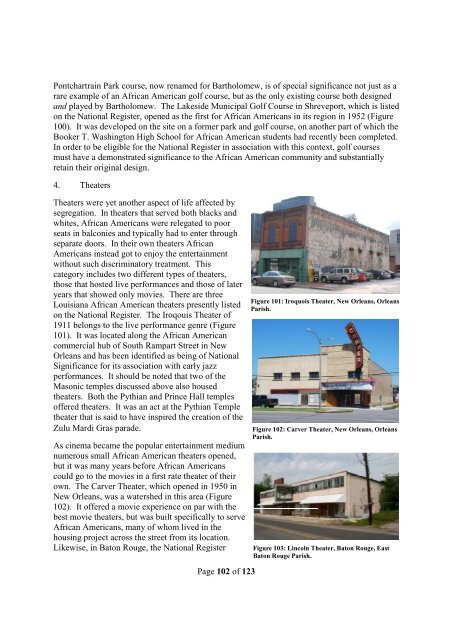The African American Experience in Louisiana
The_African_American_Experience_in_Louisiana
The_African_American_Experience_in_Louisiana
- No tags were found...
You also want an ePaper? Increase the reach of your titles
YUMPU automatically turns print PDFs into web optimized ePapers that Google loves.
Pontchartra<strong>in</strong> Park course, now renamed for Bartholomew, is of special significance not just as a<br />
rare example of an <strong>African</strong> <strong>American</strong> golf course, but as the only exist<strong>in</strong>g course both designed<br />
and played by Bartholomew. <strong>The</strong> Lakeside Municipal Golf Course <strong>in</strong> Shreveport, which is listed<br />
on the National Register, opened as the first for <strong>African</strong> <strong>American</strong>s <strong>in</strong> its region <strong>in</strong> 1952 (Figure<br />
100). It was developed on the site on a former park and golf course, on another part of which the<br />
Booker T. Wash<strong>in</strong>gton High School for <strong>African</strong> <strong>American</strong> students had recently been completed.<br />
In order to be eligible for the National Register <strong>in</strong> association with this context, golf courses<br />
must have a demonstrated significance to the <strong>African</strong> <strong>American</strong> community and substantially<br />
reta<strong>in</strong> their orig<strong>in</strong>al design.<br />
4. <strong>The</strong>aters<br />
<strong>The</strong>aters were yet another aspect of life affected by<br />
segregation. In theaters that served both blacks and<br />
whites, <strong>African</strong> <strong>American</strong>s were relegated to poor<br />
seats <strong>in</strong> balconies and typically had to enter through<br />
separate doors. In their own theaters <strong>African</strong><br />
<strong>American</strong>s <strong>in</strong>stead got to enjoy the enterta<strong>in</strong>ment<br />
without such discrim<strong>in</strong>atory treatment. This<br />
category <strong>in</strong>cludes two different types of theaters,<br />
those that hosted live performances and those of later<br />
years that showed only movies. <strong>The</strong>re are three<br />
<strong>Louisiana</strong> <strong>African</strong> <strong>American</strong> theaters presently listed<br />
on the National Register. <strong>The</strong> Iroqouis <strong>The</strong>ater of<br />
1911 belongs to the live performance genre (Figure<br />
101). It was located along the <strong>African</strong> <strong>American</strong><br />
commercial hub of South Rampart Street <strong>in</strong> New<br />
Orleans and has been identified as be<strong>in</strong>g of National<br />
Significance for its association with early jazz<br />
performances. It should be noted that two of the<br />
Masonic temples discussed above also housed<br />
theaters. Both the Pythian and Pr<strong>in</strong>ce Hall temples<br />
offered theaters. It was an act at the Pythian Temple<br />
theater that is said to have <strong>in</strong>spired the creation of the<br />
Zulu Mardi Gras parade.<br />
As c<strong>in</strong>ema became the popular enterta<strong>in</strong>ment medium<br />
numerous small <strong>African</strong> <strong>American</strong> theaters opened,<br />
but it was many years before <strong>African</strong> <strong>American</strong>s<br />
could go to the movies <strong>in</strong> a first rate theater of their<br />
own. <strong>The</strong> Carver <strong>The</strong>ater, which opened <strong>in</strong> 1950 <strong>in</strong><br />
New Orleans, was a watershed <strong>in</strong> this area (Figure<br />
102). It offered a movie experience on par with the<br />
best movie theaters, but was built specifically to serve<br />
<strong>African</strong> <strong>American</strong>s, many of whom lived <strong>in</strong> the<br />
hous<strong>in</strong>g project across the street from its location.<br />
Likewise, <strong>in</strong> Baton Rouge, the National Register<br />
Figure 101: Iroquois <strong>The</strong>ater, New Orleans, Orleans<br />
Parish.<br />
Figure 102: Carver <strong>The</strong>ater, New Orleans, Orleans<br />
Parish.<br />
Figure 103: L<strong>in</strong>coln <strong>The</strong>ater, Baton Rouge, East<br />
Baton Rouge Parish.<br />
Page 102 of 123


